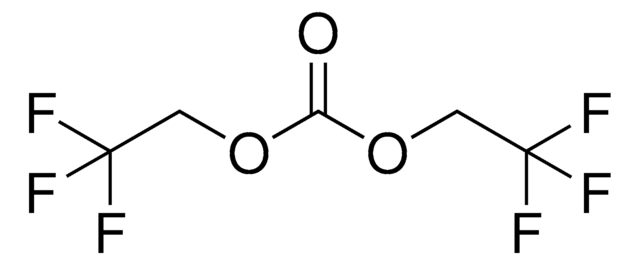917060
1 M Biphenyl in DME
a precursor solution to prepare the prelithiation/presodiation reagent for disordered carbon, SiO, Sn, Sb, P, and S electrodes
Se connecterpour consulter vos tarifs contractuels et ceux de votre entreprise/organisme
About This Item
Formule empirique (notation de Hill):
C12H10
Poids moléculaire :
154.21
Numéro MDL:
Code UNSPSC :
12352401
Nomenclature NACRES :
NA.23
Produits recommandés
Niveau de qualité
Forme
liquid
Concentration
1 M
Application(s)
battery manufacturing
Température de stockage
2-8°C
Catégories apparentées
Application
This product is biphenyl (Bp) solution in anhydrous DME (1 mol/L) is a precursor reagent that could be easily handled to prepare prelithiation or presodiation reagent. By direct reaction of Li metal, it forms a strong reducing reagent of Li-Bp. The resulting Li-Bp/DME reagent is applicable to prelithiate most of the active materials for Li ion batteries, such as Sn, Sb, P, S, SiO and other metal oxide. On the other hand, a presodiation reagent can be prepared by reacting Bp/DME solution with Na metal. Na-Bp/DME reagent can be used to presodiate hard carbon, a promising anode material in Na ion batteries.
Notes préparatoires
Suggested Directions for use:
To prepare 1 M Li-Bp/DME reagent, > 0.07 g of Li metal is added into every 10 ml of 1 M BP/DME solution.
To prepare 1 M Na-Bp/DME reagent, > 0.23 g of Na metal is added into every 10 ml of 1 M BP/DME solution.
- Step 1 Preparation of Prelithiation/presodiation reagent
To prepare 1 M Li-Bp/DME reagent, > 0.07 g of Li metal is added into every 10 ml of 1 M BP/DME solution.
To prepare 1 M Na-Bp/DME reagent, > 0.23 g of Na metal is added into every 10 ml of 1 M BP/DME solution.
- Step 2 Prelithiation/presodiation of electrodes
Mention d'avertissement
Danger
Mentions de danger
Classification des risques
Acute Tox. 4 Inhalation - Aquatic Chronic 2 - Eye Irrit. 2 - Flam. Liq. 2 - Repr. 1B - Skin Irrit. 2 - STOT SE 3
Organes cibles
Respiratory system
Risques supp
Code de la classe de stockage
3 - Flammable liquids
Classe de danger pour l'eau (WGK)
WGK 2
Point d'éclair (°F)
33.8 °F
Point d'éclair (°C)
1 °C
Certificats d'analyse (COA)
Recherchez un Certificats d'analyse (COA) en saisissant le numéro de lot du produit. Les numéros de lot figurent sur l'étiquette du produit après les mots "Lot" ou "Batch".
Déjà en possession de ce produit ?
Retrouvez la documentation relative aux produits que vous avez récemment achetés dans la Bibliothèque de documents.
High performance lithium-ion and lithium?sulfur batteries using prelithiated phosphorus/carbon composite anode.
Wang G, et al.
Energy Storage Materials, 24, 147-152 (2020)
High performance lithium-ion and lithium−sulfur batteries using prelithiated phosphorus/carbon composite anode..
Wang F, et al.
Energy Storage Materials, 24, 147-152 (2020)
Gongwei Wang et al.
ACS applied materials & interfaces, 11(9), 8699-8703 (2019-02-20)
This study reports an ambient-air-tolerant approach for negative electrode prelithiation by using 1 M lithium-biphenyl (Li-Bp)/tetrahydrofuran (THF) solution as the prelithiation reagent. Key to this strategy are the relatively stable nature of 1 M Li-Bp/THF in ambient air and the
Notre équipe de scientifiques dispose d'une expérience dans tous les secteurs de la recherche, notamment en sciences de la vie, science des matériaux, synthèse chimique, chromatographie, analyse et dans de nombreux autres domaines..
Contacter notre Service technique











